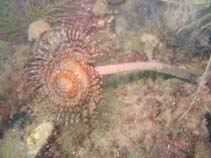Sabella spallanzanii (Viviani, 1805)
Peacock feather duster
Классификация / Names народные названия | синонимы | CoL | ITIS | WoRMS
Polychaeta | Sabellida | Sabellidae
Environment: milieu / climate zone / пределы глубины / distribution range экология
; пределы глубины ? - 30 m (ссылка 76803). Subtropical
Distribution страны | регионы FAO | Ecosystems | места находок | интродукции
Indo-West Pacific, Northeast Atlantic and the Mediterranean.
Length at first maturity / Size / Weight / Возраст
половая зрелость: Lm ? range ? - ? cm Max length : 70.0 cm TL самец/пол неопределен; (ссылка 76803)
Life cycle and mating behavior половая зрелость | размножение | нерест | Eggs | Fecundity | Larvae
Основная ссылка
ссылки | координатор | соавторы
Cardigos, F., F. Tempera, S. Avila, J. Gonçalves, A. Colaço and R.S. Santos 2006 Non-indigenous marine species of the Azores. Helgol Mar Res 60:160-169. (ссылка 3512)
Статус Красного Списка МСОП
(ссылка 130435: Version 2025-1)
Статус СИТЕС (ссылка 108899)
CMS (ссылка 116361)
Угроза для людей
Использование человеком
| FishSource |
инструменты
дополнительная информация
состав пищи
потребление пищи
хищники
Max. ages / sizes
Length-weight rel.
Length-length rel.
Размерный состав
Mass conversion
численность
ресурсы в Интернет
BHL | BOLD Systems | CISTI | DiscoverLife | FAO(Publication : search) | Fishipedia | GenBank (Геном, Нуклеотид) | GloBI | Gomexsi | Google Books | Google Scholar | Google | PubMed | Tree of Life | Wikipedia (Вперёд, поиск) | Zoological Record



